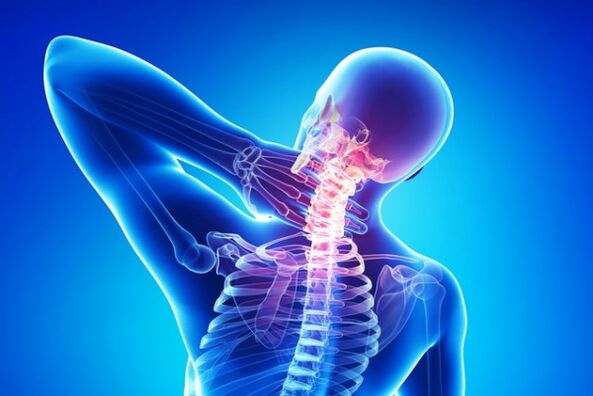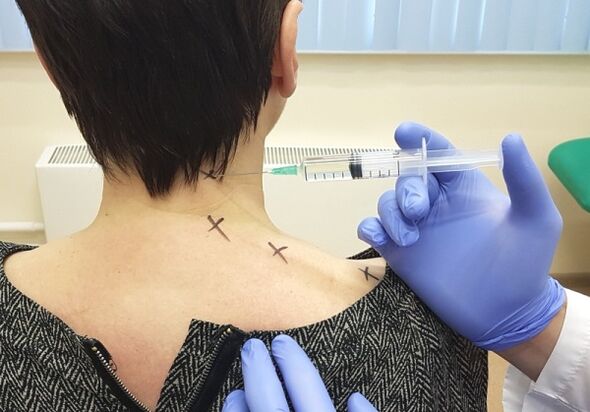Cervical back osteochondrosis is one of the types of common osteochondrosis. It is manifested by degenerative destruction of adjacent discs and beads. At the same time, the arteries and nerve endings are attracted to the pathological process. Recently, cervical osteochondrosis has become much younger. If in the last century the disease was the part of the elderly, today young people 23-40 years old suffer from it, perhaps older. Such dystrophy accounts for up to 40% of the total number of patients.

Reason
Why is cervical osteochondrosis developing? It is proven that the most common cause of pathology is the lack of active movements. Work sitting with an elongated neck forward or a bent head - this is how the work day of office employees and representatives of many other specialties passes. Arriving home, most sit back for a computer or TV. A similar way of life leads to a deterioration of blood flow to the spinal arteries, followed by disk dystrophy and the destruction of the vertebrae. The considered factor is far from the sole culprit of the disease. There are other causes of cervical osteochondrosis. For example, many experts attach great importance to hypothermia and hereditary weakness of the intervertebral joints, ligaments and muscles. The following factors become the initial mechanism for the development of neck osteochondrosis:
In post -menopausal women, the cause of progressive cervical spine dystrophy is a decrease in estrogen production with the simultaneous development of osteoporosis.
Symptoms
Symptoms of osteochondrosis can occur both at the beginning of the disease and later, in the chronic phase. It all depends on the degree of dystrophy, the presence of accompanying pathologies and a combination of adverse conditions. The main symptoms of cervical back osteochondrosis:
Pain for cervical osteochondrosis can give anywhere - on the shoulder, elbow, ears, under the shoulder blade. A distinctive feature of unpleasant sensations is surprise. In an acute attack, the discomfort disappears as suddenly it happens. Dizziness for neck osteochondrosis is often associated with disorientation, a bell in the ear, loss of consciousness, nausea, migraine. Pressure increases occur several times a day and are poorly borrowed in medical correction. Symptoms of damage to the cervical vertebrae that occur in the brain are based on the deterioration of blood flow and tissue trophism. As a result of compression of the spinal artery and oxygen hunger in patients, the following disorders manifest:
Signs of cervical osteochondrosis in women appear somewhat earlier than in men and continue more pronounced. The first symptoms of diseases, as a rule, are brain disorders, often which are written in a PMS or hormonal failure. Then there is dizziness, migraines, loss of consciousness. Symptoms of cervical osteochondrosis in men do not occur so intensely and often resemble an attack of angina pectoris with simultaneous, mixed shortness of breath, discomfort behind the sternum. Only a specialist can determine the true cause of such manifestations, he will be able to provide primary help, so he should not be delayed by his visit.
degree
Considering and analyzing the procedure for developing changes in vertebra tissue, doctors set several stages of osteochondrosis of the cervical region:

Depending on the localization of the pain, the following type of disease is distinguished: and the cervix. According to the method, of course, the disease is common to divide into acute intervertebral neck osteochondrosis, which appears for the first and chronic time, extending for years with continuous remissions and irritation.
Which doctor treats cervical osteochondrosis?
The variety of symptoms, often hidden under the guise of another illness, makes patients a logical question - which doctor to contact? When any pain in the neck, shoulder and hands or the appearance of neurotic disorders, it is urgent to approach the neurologist. And to whom to contact if there are no such specialists in the local clinic? In this case, the ticket should be postponed to the therapist. The doctor will prescribe treatment or send a close specialization to the doctor.
Troubleshooting
The diagnosis of cervical osteochondrosis begins with a visual examination and patient survey. The neuropathologist is interested in the patient's life and work conditions, the presence of chronic illnesses, food and motor activity. A preliminary diagnosis is confirmed by conducting instrumental research:
Hormone analysis is required for the fairer sex. Without it, the treatment of cervical osteochondrosis in women does not begin. To exclude pathologies with such symptoms, a differential diagnosis is performed by the appointment of additional consultations with a surgeon, gynecologist, cardiologist, ophthalmologist and lore.
Treatment
First aid for sharp pain in the cervical segment involves taking anesthesia and providing the rest of the affected area. Distribution therapy - Pepper pieces, applying heat ointments helps well. However, such measures are unable to cope with the disease. They only temporarily relieve the patient's condition. Treatment for osteochondrosis of the cervical spine is comprehensive. Its main purpose is to eliminate the pain and slow down the destruction of discs and beads. For this, different types of therapy are prescribed: medicines, exercise therapy, massage, wearing an orthopedic collar. The treatment of cervical osteochondrosis in women has a number of features and is primarily aimed at eliminating the symptoms that occur in the brain. Another effective remedy for neck pain is physiotherapy. Treatment is prescribed both during irritation and prayer. The following procedures face the symptoms of osteochondrosis:
Directly facilitates the condition of patients with therapeutic massage. Perform it only in the phase of forgiveness. To achieve an ongoing result, therapy is performed by a course consisting of 9-10 procedures. Healing gymnastics is very effective for osteochondrosis of the cervical region. Dosage load strictly eliminates discomfort quickly, improves vertebral mobility, strengthens muscles and increases blood flow. Often patients with osteochondrosis turn into recipes for traditional medicine, hoping for a cure. It should be remembered that all non -traditional agents are only permissible as an addition to the main therapy prescribed by the doctor. Is it possible to fully cure cervical osteochondrosis? Unfortunately not. Medications and other conservative methods can only suspend the dystrophic process and eliminate symptoms. Even after satisfactory therapy, the affected discs are still replaced by connective tissue and lose their functionality.
Complications
The cervical back osteochondrosis is dangerous with its complications. With the unfavorable development of the disease, squeezing the spinal artery can result in a brain stroke, continuous deterioration of hearing and vision. Often, a hernia, severe hypertension and numbness or finger cooling join osteochondrosis. In women, complications of a neurological nature often develop - constant fatigue, lethargy, loss of performance, excessive dissatisfaction.
PREVENTION

Prevention of cervical back osteochondrosis involves affordable physical activity, a balanced diet with a sufficient amount of calcium and phosphorus, control over weight and maintain proper behavior. All of the above should become a habit and strictly fulfilled, better from early childhood. Office workers and those who spend many hours after the monitor screen to prevent neck osteochondrosis should adhere to simple recommendations:
After a working day, it is recommended to lie on a flat surface without a pillow for 15-20 minutes or ask the family to make a light massage. This will help relieve cervical muscle tension and rest. Excellent prevention of degenerative changes will not be traumatic and swimming sports. Osteochondrosis identified and curated in time of the cervical region may not manifest for many years, allowing the patient to lead a completely comfortable life. And with a regular preventive administration used for the prevention and treatment of medication osteoarthritis, the disease will cease to worry even in old age.



















